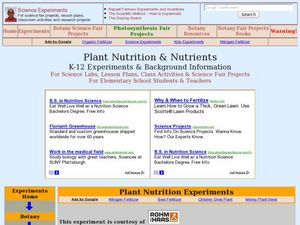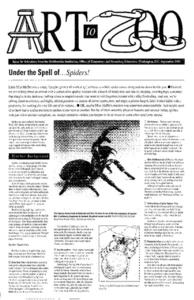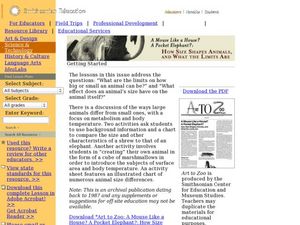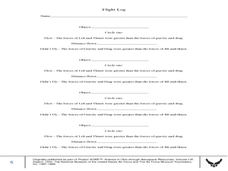Curated OER
Plant Nutrition and Nutrients
Students observe seeds growth and examine the different parts of the seedling. In this biology lesson, students compare the growth of seeds planted in soil and in hydroponics. They record their observations in their science journal and...
Curated OER
Under the Spell of Spiders
Young scholars examine spiders. In these spider lessons, students will view spider images and live spiders to determine physical characteristics, habits, and habitats. Young scholars will examine fantasy and folklore about spiders to...
Curated OER
How Size Shapes Animals
Learners investigate how size affects large and small animals differently. In this animal lesson plan, students determine how size affects different animals by constructing their own animal out of marshmallows. Once learners create...
Curated OER
Paper Dart Airplane
Students create a paper dart airplane and measure its flight pattern. In this flight lesson, students follow the included directions to build their own paper airplane. The students change the aileron configurations to see how it affects...
Curated OER
The Human Memory
This is a well-designed, creative lesson to help students learn more about the human memory. Working in pairs, students complete tasks and gather data. Excellent websites for resources are also provided.
Curated OER
Engineering For The 3 Little Pigs
Students engage in a lesson which demonstrates the importance of rocks, soils and minerals in engineering and how using the right material for the right job is important. The students build three different sand castles and test them for...
Curated OER
Household Things that Fly and Why!!!
Young scholars examine the four forces of flight. In this flight lesson, students test to see which types of items will fly. Young scholars make predictions on whether the item will fly or not. Students gain knowledge about lift,...
Curated OER
Recycling & Our Environment
Young scholars present information about recycling to other students. In this environmental protection instructional activity, young scholars create a puppet show or commercial about the importance of recycling for other students to view.
Curated OER
2.0 "Water Is Life" Global Water Awareness Mini-Unit (Grades3-5)
Students study the amount of potable water on the Earth. In this water lesson, students examine the amount of potable water as compared to all the water on the Earth. They discuss why many parts of the world do not have access to good...
Curated OER
How Plants Help Us Breathe
Third graders discuss how humans breathe and how plants help us to stay alive. In groups, they identify and label the different parts of plants and describe their functions. They compare and contrast the ways plants and animals breathe...
Curated OER
Honing in on Hummingbirds
Students explore ruby-throated hummingbirds. In this cross-curricular hummingbirds lesson, students listen to the book The Mystery of the Missing Hummingbirds and choose related topics to research with a partner. Students draw or...
Curated OER
Flight Dreams - Flight Factors
Students investigate the physics of flight by experimenting in class. In this history of flight lesson, students define terms such as gravity, lift, and drag in order to better understand how a plane is able to stay in the air....
Curated OER
Birds Around the Village
Students observe the physical characteristics of birds and identify birds found in their village. They describe characteristics, behaviors and habitats of local birds in this series of lessons.
Curated OER
The Monarch Butterfly Watch
Students explore monarch migration through the Journey North web site. In this butterfly instructional activity, students use the internet to identify a butterfly's migration pattern. Students write in electronic journals.
Curated OER
Why is it so hot when I sit next to the window?
Students investigate how energy travels through glass. In this energy usage lesson, students conduct an experiment in which they decide if window film affects how much energy travels through the glass. Students use a journal to make...
Curated OER
Measuring Animal Sizes (and Relative Sizes in our Animal Environment)
Students discover the actual size and weight of many insects and animals. In this biology instructional activity, students investigate animals and insects to determine their actual weight and size. In groups, students create an animal or...
Curated OER
A Frog's Life Story
Students investigate the lives of frogs by completing several worksheets. In this biology lesson, students discover the life cycle of a frog from tadpole to death. Students complete frog life cycle puzzle as well as create a...
Curated OER
Four Color Map
Young scholars explore geometry by completing a color puzzle. In this shape identification lesson, students utilize deductive reasoning to complete a Google SketchUp puzzle with trapezoid, triangles and rectangular shapes. Young...
Curated OER
What Lives in the Open Ocean and Where Do They Live?
Young scholars explore oceanography by participating in a flash card activity. In this ocean inhabitant lesson, students define a list of ocean related vocabulary terms and answer ocean geography study questions. Young scholars utilize...
Curated OER
Food Pyramid
Third graders examine healthy eating habits by identifying the food pyramid. In this personal health lesson, 3rd graders discuss their own eating habits and how there should be a variety of foods in all diets. Students...
Curated OER
Keep Track of time by watching the clock
Learners answer questions about the clock. In this time lesson, students answer questions using intervals of five minutes. Learners solve problems about how long to the next activity, how much longer, and whether or not we have...
Curated OER
Natural Disasters: An Adventure in Non-Fiction
Students study different natural disasters. In this natural disaster lesson students read a nonfiction book followed by a discussion, an experiment, then collect illustrations from their experience.
Curated OER
Teaching with Collections
Students examine collections. In these real-world collections lessons, students examine and describe buttons and shells. Students will then sort, classify, and graph items according to various indicated descriptors.
Curated OER
What Temperature Is It?
Learners answer the question, What is temperature? For this temperature lesson, students use hot chocolate and ice cubes to measure temperature with a thermometer (Fahrenheit and Celsius). This lesson includes a student activity...























